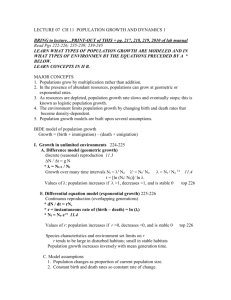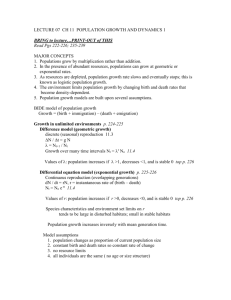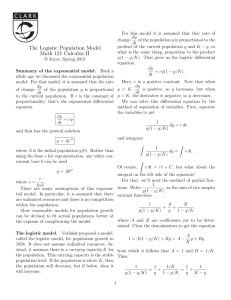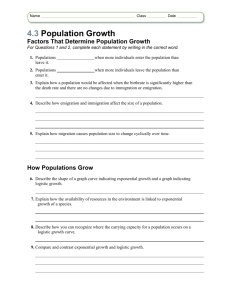Lecture 11: Intraspecific Population Regulation Dafeng Hui Office: Harned Hall 320
advertisement
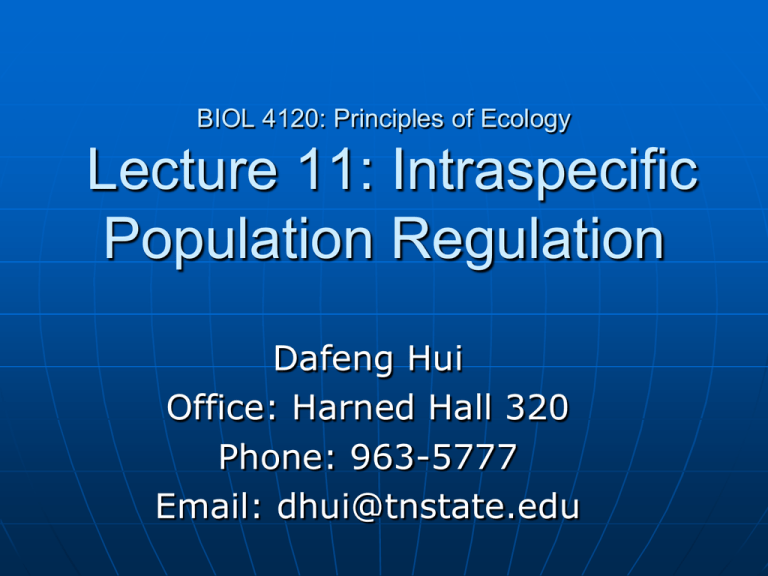
BIOL 4120: Principles of Ecology Lecture 11: Intraspecific Population Regulation Dafeng Hui Office: Harned Hall 320 Phone: 963-5777 Email: dhui@tnstate.edu 11.1 Logistic Population Growth Exponential growth model can not explain the population growth here Need other equation Barnacle Birth rate and death rate change with population size N dN/dt=rN r=b-d b=b0-aN d=d0+cN dN/dt=[(b0-d0)(a+c)N]N dN/dt=(b0-d0)[1(a+c)/(b0-d0)*N]N dN/dt=r N(1-N/K) K=(b0-d0)/(a+c) K: carrying capacity: maximum sustainable population size under prevailing environmental environment. From exponential growth to logistic growth Logistic population growth Logistic Population Growth Logistic Population Growth As resources are depleted, population growth rate slows and eventually stops: logistic population growth. • Sigmoid (S-shaped) population growth curve. • Carrying capacity (K) is the number of individuals of a population the environment can support. • (r) is per capita increase rate. A few examples 11.2 Population regulation involves density dependence Environment limits population growth by altering birth and death rates. • Density-dependent factors E.g., Disease, Resource competition They influence a population in proportion to its size Resulted in slowing the rate of increase • Density-independent factors E.g., Natural disasters Influence population without regard to the # of individuals or if the proportion of individuals affected is the same at any density Regulation of population size by densitydependent factors Regulation of population size by densitydependent factors 11.3 Competition results when resources are limited Intraspecific competition: competition among individuals of the same species • Scramble competition: growth and reproduction are depressed equally across individuals in a population All individuals receiving insufficient resources local extinction • Contest competition: some individuals claim enough resources while denying others a share A fraction of the population suffers. Successful competitors to sustain the population. Competition results when resources are limited Exploitation: indirectly influencing each other by consuming the same resources (eat same grass by zebras , compete for water uptake by trees, indirectly) Interference: direct influencing each other by preventing others to occupy a habit or access resources (birds, animals). 11.4 Intraspecific competition affects growth and development Intraspecific competition is usually density-dependent. It increases gradually, at first affects growth and development, then individual survival and reproduction. Relationship of body growth and density Tadpole and white clove Horseweed experiment Kyoji Yoda, plant ecologist Horseweed was planted at a very high density (100,000 seeds m-2) Density declined in several months Weight per seedling Self-thinning: progressive decline in density increased. and increase in biomass of remaining individuals in a population. 11.5 Intraspecific competition can reduce reproduction Intraspecifc competition can function to reduce fecundity corn Harp seals shrub Growth and mortality in steelhead trout (Keeley et al.) 11.6 Territoriality can function to regulate population growth Home range: the area that an animal normally use during a year Home range varies with the available of food resources, model of food gathering, body size and metabolic needs. Territory: a defended area by an animal. • Territory could be part of or the same as home range. • Use well-defined behavioral patterns: song and call, intimidation displays, attack and chase, marking with scents. Territories of the grasshopper sparrow Territory is protected • • • • • • Food Mating Nesting site Attraction of mates Avoidance of suboptimal habitat Needs energy May not be optimal strategy when resources are low 11.7 Density-independent factors can influence population growth Factors such as temperature, precipitation and natural disasters (fire, flood and drought) are densityindependent factors The End Modes of Competition Intraspecific: • Competition with members of own species. Interspecific: • Competition between individuals of two species - reduces fitness of both. Intrinsic Rates of Increase On average, small organisms have higher rates of per capita increase and more variable populations than large organisms. Compare of logistic with exponential growth curves Prediction of growth for gray squirrel population r=0.18, K=200, N0=30

